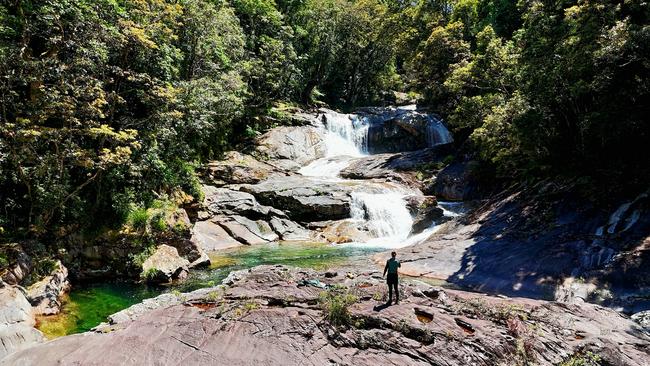
Keen bushwalkers say Far North Queensland’s rainforest has the potential to become an international hiking mecca among the best in the world.
But that will only happen if the state government expands on the eco-tourism potential of multi-day treks such as the under-construction Wangetti Trail.
And with the new LNP government seeking submissions on what the state’s approach to tourism over the next two decades should look like, now is the time for the Far North to make its case.
For most, Wooroonooran National Park is the funny-sounding name for the wild, untamed tropical jungle that carpets the peaks of Bellenden Ker and Bartle Frere to the south of Cairns.
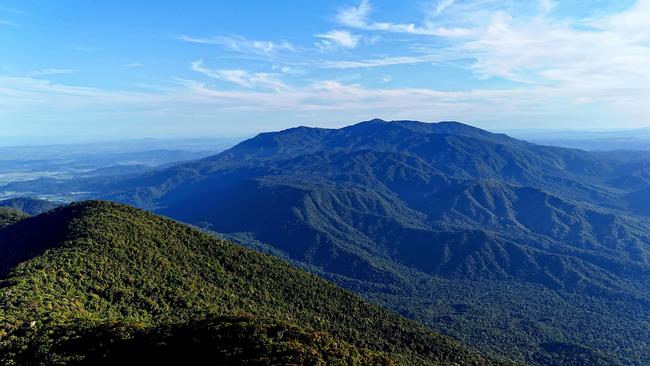
For off-grid hiker Sean Dromey, it’s a second home.
The 33-year-old trade instructor caterer estimates he’s mapped out and trekked roughly 2000km of trails across Far North Queensland since he arrived in the tropics in 2019.
And it’s Wooroonooran – with its steep valleys, epic rock formations, pristine waterfalls and exceptional biodiversity – which he believes could be the location of Queensland’s next great walk.
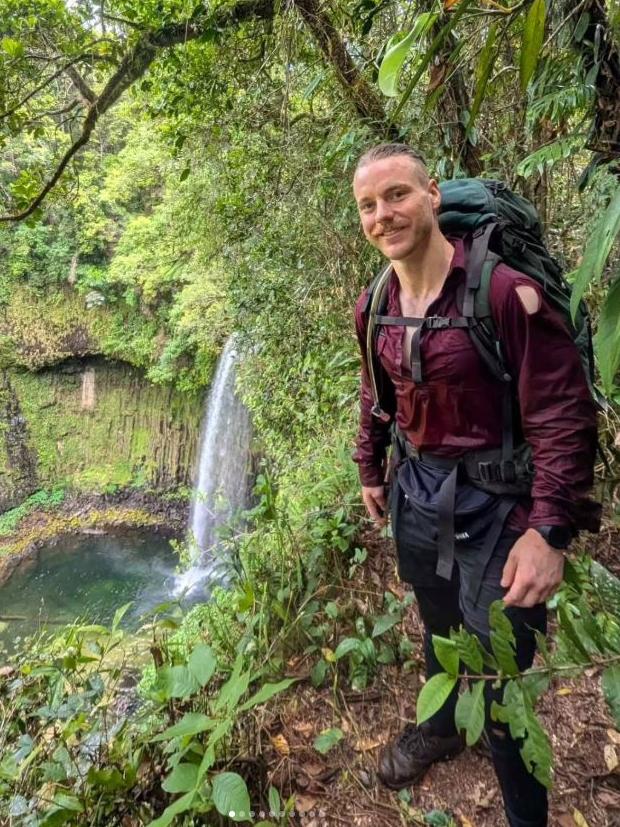
Ask your average Aussie bushwalker where the best place to go on a multi-day hike is and Queensland doesn’t usually rate a mention.
The go-to destinations are Tasmania – famed for hikes such as the Overland Track or Three Capes Track – or New Zealand, with its myriad of “Great Walks” including the Milford or Routeburn Tracks.
These days, scoring passes to walk the famed Milford Track during the peak summer season in any given year is akin to trying to buy tickets to a Taylor Swift concert – such is the 53km-long hike’s international popularity.
It and the Overland Track regularly feature in lists of the world’s best multi-day hikes.
But Mr Dromey believes that by building trails in the right places through Wooroonooran, it would put Far North Queensland – and therefore Queensland – on the world map for hikers.
“I personally think bushwalking here would explode,” he said.
“I think we would be on par with New Zealand and Tasmania and we would bring in just as much people for exploring and bushwalking as they do, if not more, because of what’s contained in those forests.”
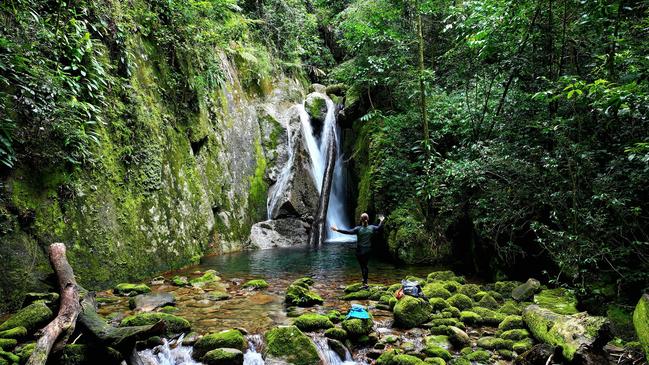
An Irishman in the jungle
In one way, Mr Dromey is an unlikely advocate for building walking trails through Tropical North Queensland’s lush jungle.
Hailing from Cork, Ireland, he’s a long way from home, where he first developed a love of walking in the forest more than two decades ago with his dad.
“It’s the simplest of things, when you’re walking, and the twigs are breaking and crackling under your feet or the fact you can hear the birds chirping, or the creek, I fell in love with the sounds, it was like a symphony,” he said.
A love of walking transformed into a love of mountaineering, and subsequently, off-track navigation.
He arrived in Far North Queensland in March 2019 after completing his full-time studies.
“And as soon as I started exploring the rainforest, I said to my mum: ‘I don’t think I’m ever coming back (home)’.”
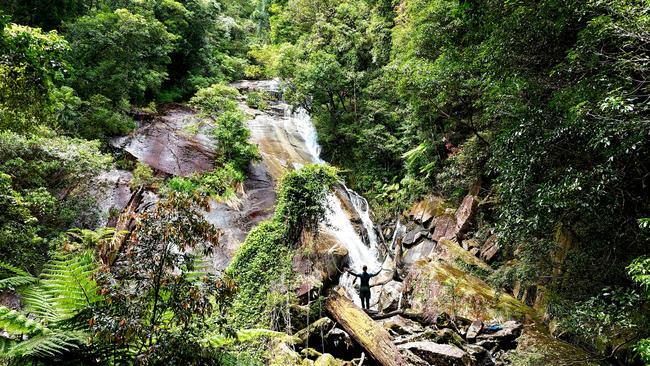
Mr Dromey has always been hungry for adventure, he said, explaining why in 2019 he set about challenging himself – and succeeding – in running up and down Queensland’s tallest mountain, Mount Bartle Frere, with two 15kg dumbbells in hand and a 20kg weight vest around his torso.
Becoming extremely fit has allowed him to explore parts of Far North Queensland that are essentially inaccessible to most people.
One of the biggest expeditions he’s completed was from Mount Windsor on the Tablelands through to Adeline Falls – a series of 16 waterfall tiers cascading down a massive rock face that’s 250m high and overlooks the Daintree.
“Photos don’t do that sort of stuff justice. When you’re there and you’re in the flesh, it’s euphoric,” he recalled.
“The fact that you could be the first person there in God knows how long.
“I’ve actually got to the point now where it’s almost insatiable. I just want more and more. And that’s why I’m constantly upgrading myself so that I can see more.”
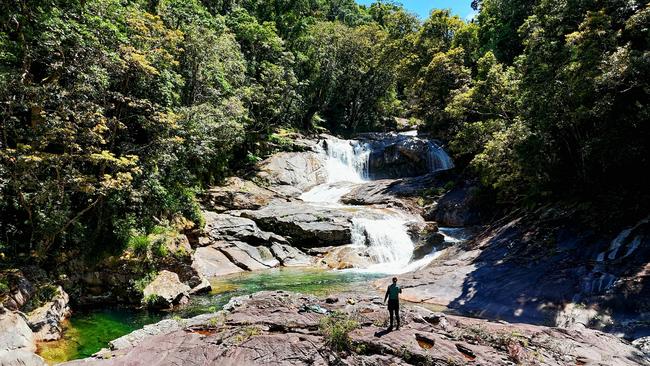
After wandering through a “phenomenal amount” of Wooroonooran, in October last year Mr Dromey completed a three-day off-trail hike from Behana Gorge to Babinda, following the towering ridge lines and plunging canyons of Bellenden Ker.
Along the way he came across purple kauris, the rare and gigantic stockwelia tree – of which only small pockets are believed to remain on the mountain and on the Tablelands near Windin Falls – waterholes that are six or seven metres deep and so clear you can see straight to the bottom, spectacular waterfalls and even a cave full of Indigenous rock art.
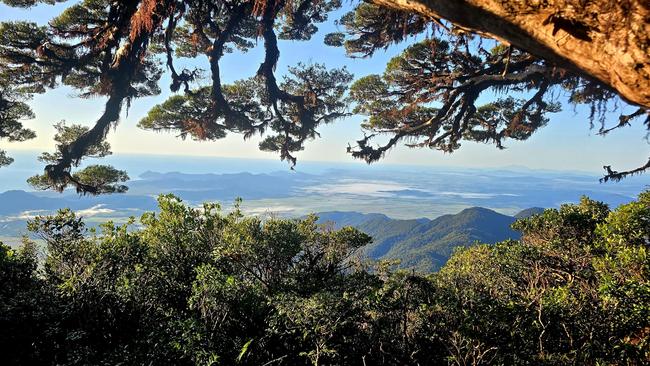
On his first night, Mr Dromey set up camp near a creek behind the centre peak of the mountain.
Making dinner while the sun went down, his campsite deep in the jungle was swarmed by hundreds of fireflies.
“The whole place was illuminated, which was an absolutely crazy experience,” he said.
He’s also taken to photographing the animals and plants he comes across.
“I’ve got friends who are experts in frogs, insects, birds, botanicals.
“And they’re just saying the stuff (I’m) finding is absolutely incredible.”
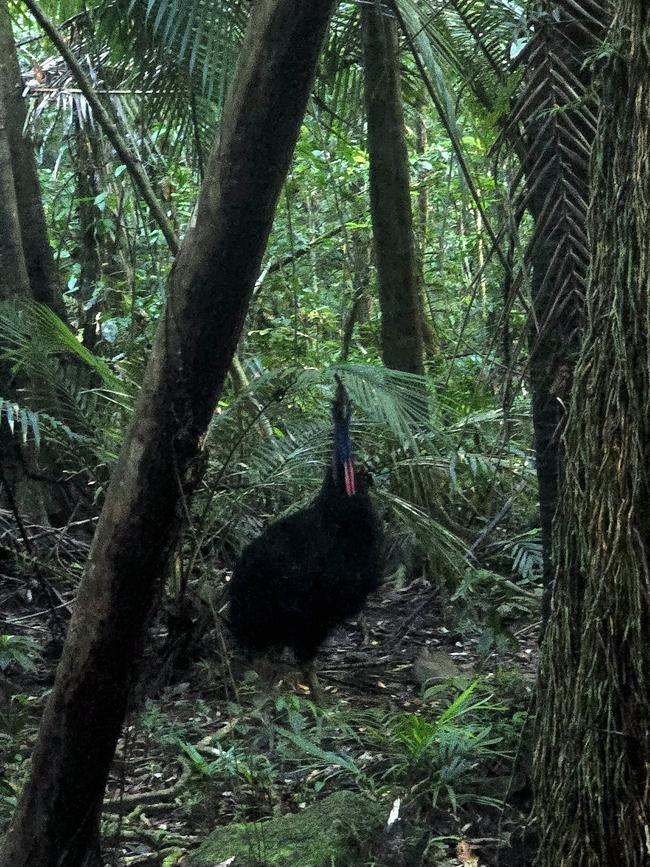
On other occasions he’s had botanical scientists contact him saying they’d seen rare species of plants.
“That’s one thing I’m going to be doing (this year) is leading a private expedition of some of Cairns’ best botanical scientists because they want to go through Bellenden Ker and then basically do studies, other than seeing the waterfalls, they want to see potentially plants that could have never been discovered before,” he said.
“It’s groundbreaking really in that sense because it’s just, it’s going to open up a whole new world and in fact actually it could increase tourism.”
In footage he recorded of one of his recent journeys, Mr Dromey’s drone starts out hovering way above the forest.
The drone slowly descends, picking up details of the forest, the creek, the flow of the water, and finally, a tiny, insignificant human figure.
“And this is basically to give people perspective of this massive void, this amazing place,” he said.
“It’s just there.
“People just don’t know.”
Queensland eco-tourism push
Queensland’s approach to eco-tourism in the past has left a lot to be desired.
Nowhere is this more evident than the development and delivery of the Wangetti Trail.
Initially aired as a proposal from World Trails’ Glen Jacobs in 2015, the first funding for the project’s construction began to flow in 2019.
Almost six years later, only the starting 7.8km section of the 94km hiking and biking trail, and a concrete bridge across the Mowbray River, have been delivered.
The first section of the track has since been described as “underwhelming” by the state’s Environment and Tourism Minister Andrew Powell during a recent visit to Cairns, pledging his government would “deliver the Wangetti Trail and it will be spectacular”.
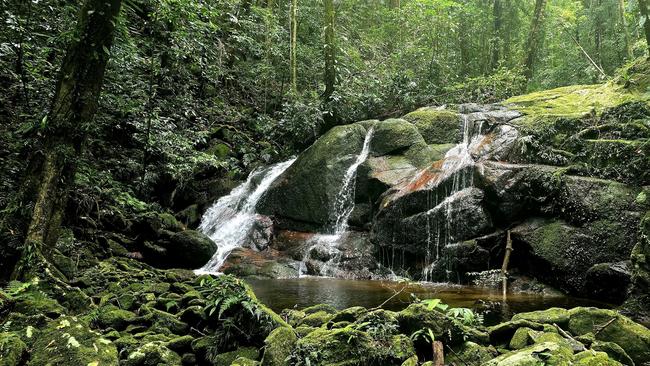
Further south, shovels are yet to hit the ground on the proposed 125km Paluma to Wallaman hiking and biking trail, which was first endorsed by the state government in 2019.
Part of the issue was explained by a Queensland Audit Office Growing eco-tourism in Queensland report from May 2023.
The report found Queensland was blessed with “world-class natural and cultural assets” and had a competitive advantage over many other locations but the previous tourism strategy, Towards Tourism 2032, had “no specific actions for developing the eco-tourism sector”.
That’s despite the strategy recognising “the opportunity for the state to lead the world in sustainable tourism and eco-tourism experiences”.
“But the Queensland government has no statewide policy on eco-tourism that clearly defines how the state’s tourism and environmental entities will work towards its vision, inhibiting eco-tourism planning and co-ordination,” the report said.
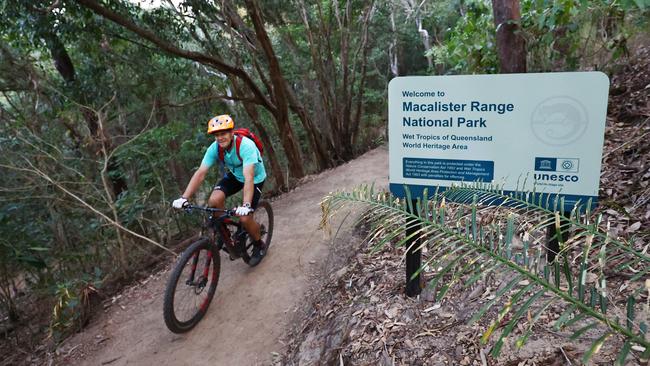
“Recognising the often competing roles and priorities of responsible entities, there is a need to establish a definition of eco-tourism and what it means to the state – both within and outside Queensland’s protected areas.”
Central to the government’s difficulties has been the inherent tension between the Department of Environment’s challenge of protecting the state’s natural environment and the Department of Tourism’s desire to derive economic benefit for Queenslanders.
“Their success to date has been limited,” the QAO found.
“Since 2013, the Department of Environment and Science has approved three eco-tourism facilities in national parks, with two more in development. The approval processes and delivery of these developments were lengthy, complex, and costly.”
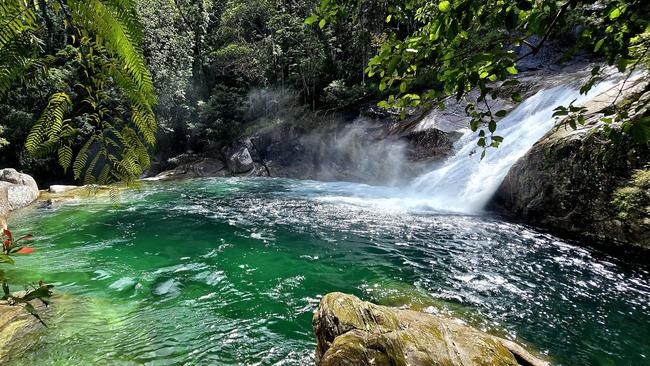
The report echoed sentiments reported in the Cairns Post in April 2023, where sources close to the Wangetti Trail project said a rift between (the Department of Tourism) and the former Department of Environment and Science over the design and function of the Wangetti Trail had been the main driver of the project’s delay of two-and-a-half years.
The departments have since the change of government in late October/November 2024 been merged into the Department of the Environment, Tourism, Science and Innovation, in an attempt to overcome “roadblocks”.
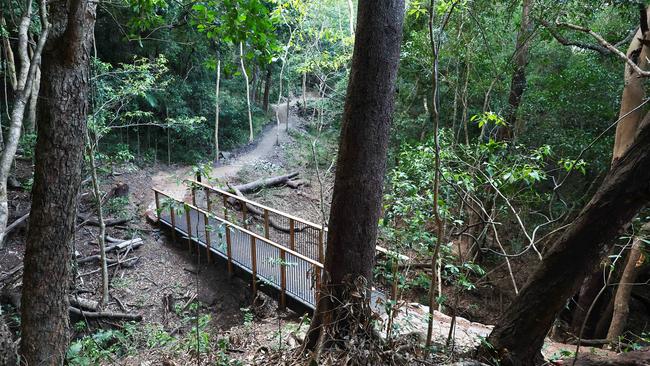
A DETSI spokeswoman in response to questions from the Cairns Post said the department was committed to unlocking the eco-tourism potential of Far North Queensland, “as part of our 20-year tourism plan Destination 2045: Queensland’s Tourism Future, and one aspect of this includes investing in walking trails”.
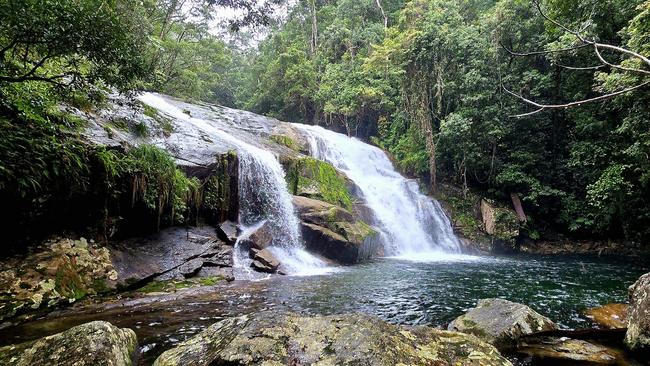
“Plans are underway to develop stunning coastal and mountain walking trails within our national parks to ensure future developments utilise our unique natural landscapes,” she said.
“We are passionate about fostering sustainable and accessible eco-tourism opportunities that acknowledge and respect the deep cultural heritage and natural landscapes in Far North Queensland, to ensure a strong and sustainable future for the Queensland tourism industry.”
Anyone can make a submission about what tourism opportunities they’d like to see created in the Far North as part of consultation on the state government’s Destination 2045 tourism strategy.
To make a submission, visit DETSI’s website before February 28.
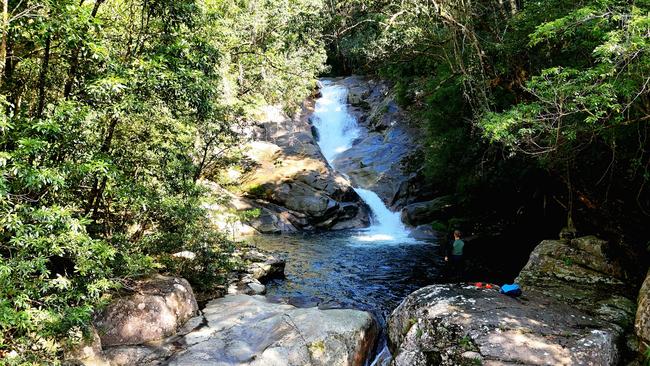
Environment and Tourism Minister Andrew Powell said the state government was “determined to make Queensland the number one tourism destination in Australia”.
“A key part of that is developing nature-based tourism products to put Queensland firmly on the map,” he said.
“We have established a Tourism Cabinet Committee to fast-track discussions between ministers about planning, transport and connectivity issues that may impact these developments.
“Our 20 year tourism plan is currently in the consultation phase, and we are hearing from stakeholders about some wonderful initiatives.”
DETSI urges visitors to national parks to stick to the designated walking tracks and pay attention to authorised signage, as people’s safety cannot be guaranteed on unauthorised walking tracks.

Add your comment to this story
To join the conversation, please log in. Don't have an account? Register
Join the conversation, you are commenting as Logout
Qld youth crime crisis: ‘We still have a long way to go’
Six months after the introduction of the state government’s tough new laws for serious youth offenders, the results are in.
Cello prodigy secured for first ever Cairns classical music festival
A classical savant and first Australian ever admitted into one of Europe’s most esteemed music schools will be a leading artist at the inaugural Cairns chamber music event next year.